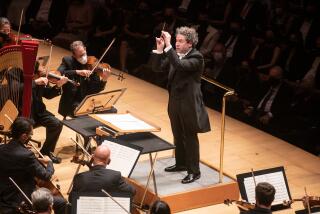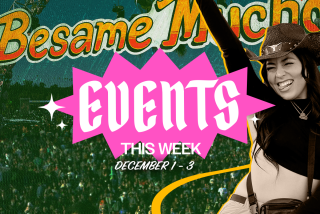The Festival of Sacred Music opens at Royce Hall

Many Southern Californians still remember the feelings of promise and unity generated by the epochal 1984 Olympic Arts Festival and its successors, the Los Angeles Festivals. Alas, the latter fell apart in the 1990s, but now it is safe to say that the World Festival of Sacred Music -- like the L.A. Festivals, a triennial event -- has filled some of the gap, tapping into the same yearning for adventure and understanding of common ground among many peoples that drove those cultural celebrations.
The Dalai Lama lighted the fuse in 1999 with a letter to Judy Mitoma (now the festival’s director) calling for music to usher in the new millennium. Four editions later, the festival has definitely taken root.
Perhaps the word “sacred” is a bit misleading, for this is not solemn, stained-glass music as the term can imply to Western audiences (although the idea of music as a sacred or necessary part of life, like food, is another way of looking at it). But the three-year wait between festivals feels right -- and the ample turnout at the opening “gala” concert in Royce Hall on Saturday night looked as varied in age and ethnicity as one might find anywhere.
The first half of the evening juxtaposed three diverse acts whose origins literally spanned the globe. Angola-born Waldemar Bastos, a star on the global music circuit, usually appears in town with his percolating Afro-pop band. But on this occasion, he was alone with just the revolving vamps of his acoustic guitar, his voice soaring through some of his most haunting material with the Brazilian and African grooves clearly implied.
Honolulu-born Emiko Susilo, a specialist in Javanese singing, combined her delicate voice with the acoustic guitar of Rob Levit, who stayed in Susilo’s sphere playing squarely on the beat with hardly a hint of his jazz background. The astonishing four-person Tuvan group Chirgilchin slipped into various degrees of throat singing, which in its most extreme multiphonic state sounds almost like electronic music. Cautiously, but with increasing confidence and swing, all of the above gradually combined forces in carefully worked-out, convincing global fusions.
The Liän Ensemble, a Los Angeles-based aggregation of Persian classical musicians, took over after intermission with a pair of lengthy, painstakingly structured compositions with words by Rumi and pounding rhythms. The members of Rupayan, from the Thar Desert of northwest India, sported wildly colorful turbans, and their joyously energetic music -- driven by the enormously swinging dholak (a large hand drum) of Umer Farukh -- belied the grim expressions on their faces.
Then came the hard part: how to combine all of the concert’s 21 musicians into one ensemble, after only one rehearsal to figure out how to do it. But they found the solution: a jam based on one note (an F) and one groove, with the singers taking turns improvising over the drone and the audience spontaneously clapping along.
And with the acceleration of the tempo near the end, something magical happened in Royce. The music lifted off ecstatically and the room almost seemed to levitate with a shared human resonance. Now and then, we can all get along.
The World Festival of Sacred Music continues throughout Los Angeles until Sept. 28. For more information, go to www.festivalofsacredmusic.
More to Read
The biggest entertainment stories
Get our big stories about Hollywood, film, television, music, arts, culture and more right in your inbox as soon as they publish.
You may occasionally receive promotional content from the Los Angeles Times.






